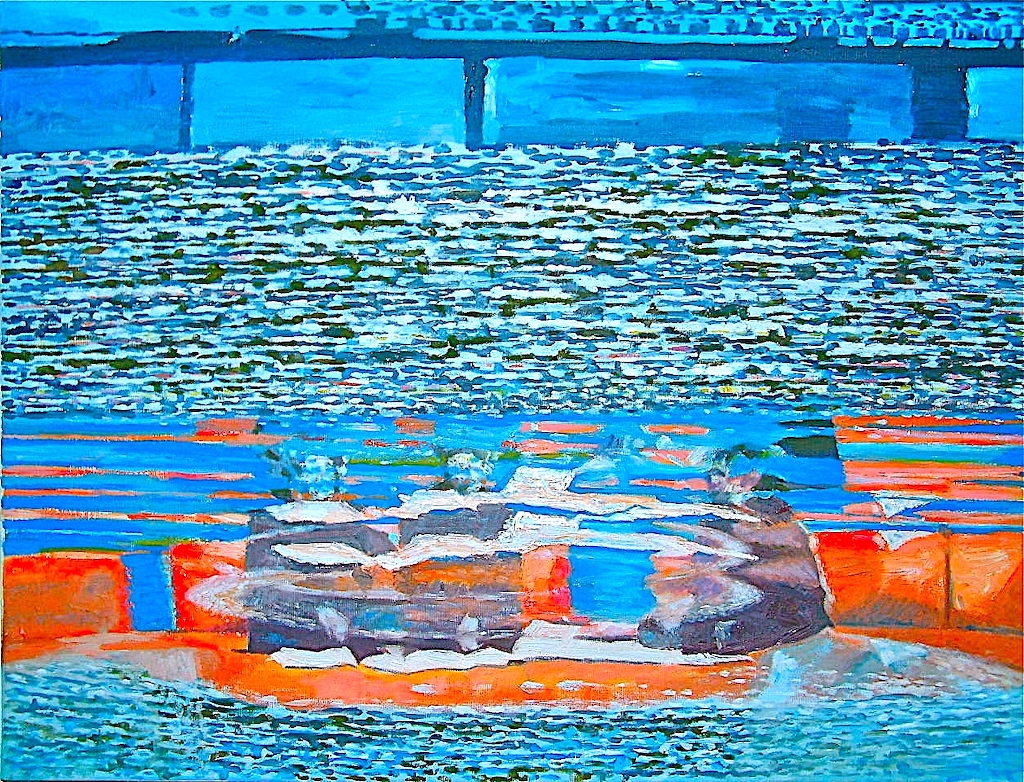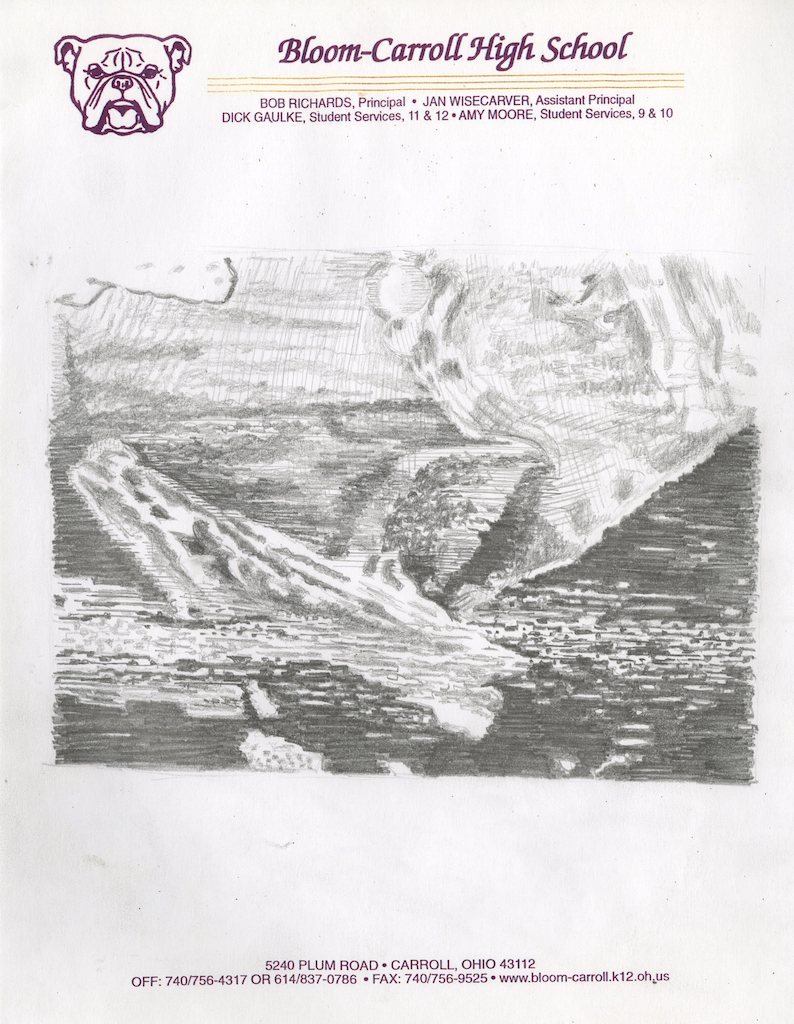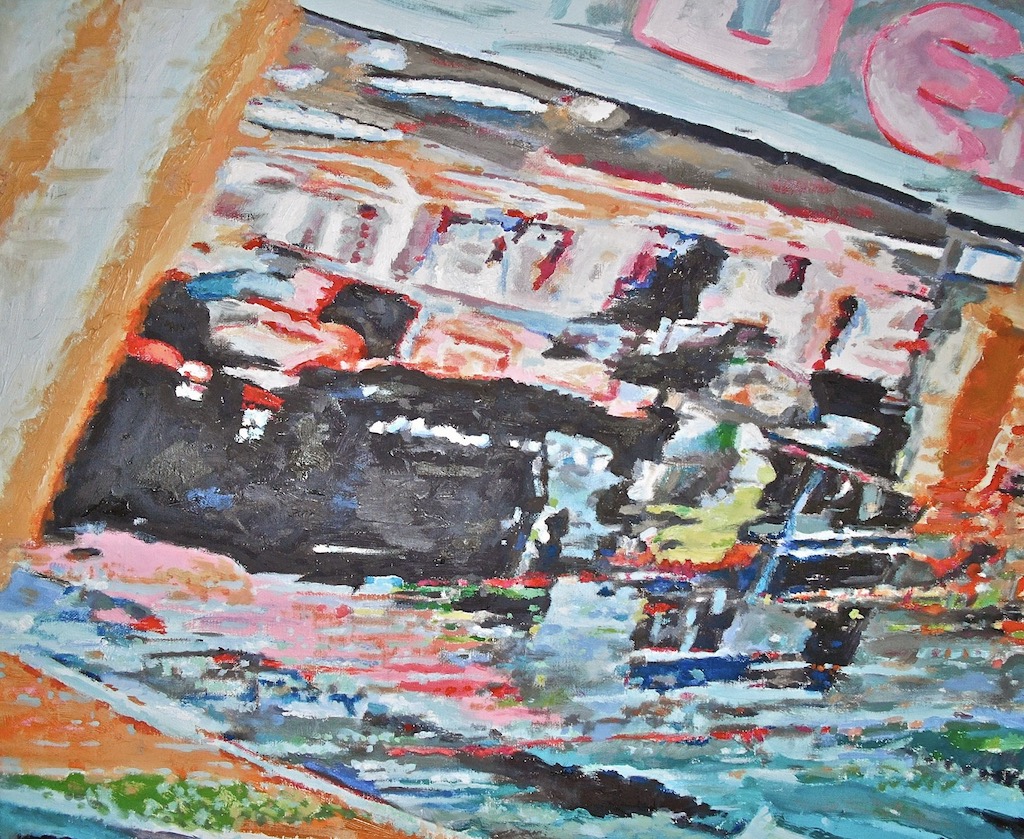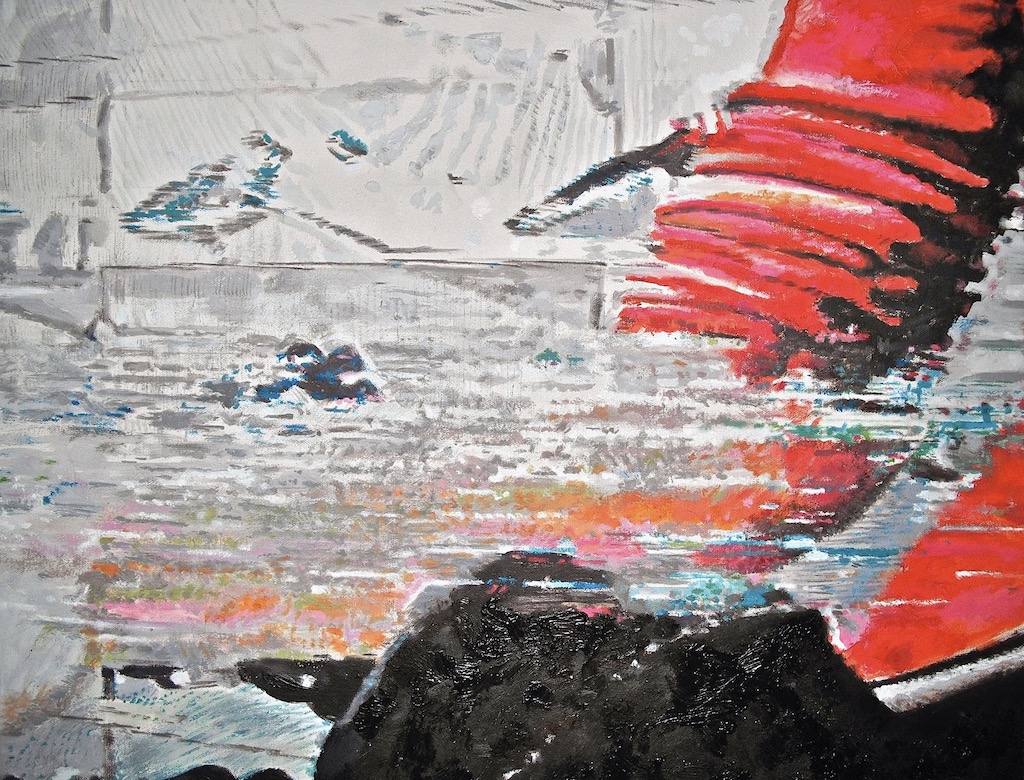VHS Tapescape
Tapescapes is a term I apply to paintings that mimic the attributes of VHS. These video landscapes were made by taking photographs of the TV screen during Fast-Forward, Pause and Rewind functions. In photographing the speeding screen the still camera fixes a new frame, altering color and reshaping the original. However, I couldn’t see what I was photographing, the images too fast for the human eye to apprehend, so I suppose that image selection was random, or maybe it is the camera that chooses.
The three images directly below were painted from recordings of TV coverage of a live darts match, the players are seen from a camera installed just above the dart board, while the central image features a Fast-Forwarding still of a split screen showing a segment of the board and the player releasing a dart. I wanted to present screen “interference and distortion” as a form, which possesses aesthetic values of formal balance and color harmony.
I developed source materials by scanning through videotape of soccer highlights. The painted divisions of the playing field somewhat echo the minimalist geometry of Mondrian and Malevich. The rectangle divided into symmetrical halves, circles and boxes, this is also reflected in the language of the game; center circle, penalty box, goal line etc.
In the following quotation, Kazmir Malevich could almost be referring to soccer, and generally speaking, sports as a diversion from the pressures of daily life.
“In the year 1913, trying desperately to free art from the dead weight of the real world, I took refuge in the form of the square.”
Furthermore, the arbitrary positions of the players seem pinned to the scan bars like musical notes, a code for the dynamism of sports theatre perhaps.
In addition to the scan bars acting as compositional devices, I’m interested in the light generated by the TV apparatus itself, a big ray gun pointing at the viewer from behind the screen. This led to thinking of how paintings have been lit by artists throughout history, and how they compare with stadium and studio lighting. The pundit paintings have a spectral quality. light is bounced around at speed by the Fast Forward and Rewind functions, and when arrested by the still camera interesting effects are produced. In the painting below, left, the scan bar breaks down horizontally and seems to levitate note paper up from the orange table. Furthermore, the awkward spread fingers placed on the pundits’ thighs are reminiscent of a bright orange Victorian seance. Aesthetically speaking, perhaps teleportation and superficial time travel are occurring due to a configuration of media, paint and canvas. This project seeks to take advantage of of what picture machines can conjure under gentle guidance.
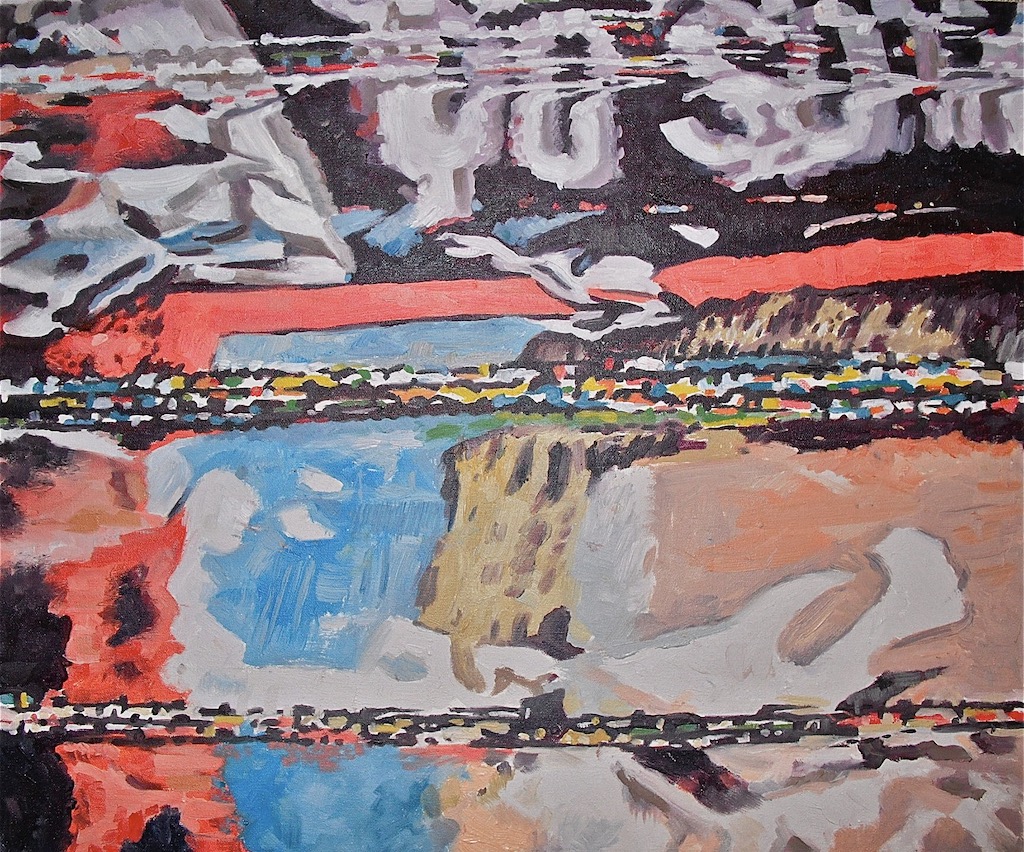
The drawings below show the contrast between VHS-sourced images made in graphite as compared to those in rendered in paint.
Act Natural: Conversation with Matthew Johns, London 2009.
Simon Oliver: What are you working on currently?
Matthew Johns: A series of paintings which take their lead from video-taped sports footage.
SO: Sports footage/
MJ: Yes, I’ve been video-taping live sports coverage, and using the material in forming an initial image, which I then paint from.
SO: Replicating video stills in paint?
MJ: Well, perhaps more extracting and adapting, recovering the viewing experience through paint. Attempting to locate similarities and points of departure the live flow of the TV image, and in the smutable painting surface. Paint is mediated during application, so it’s initially a moving image of sorts.
SO: You paint from the moving image then?
MJ: No, I use a digital camera in order to pluck out an image which may appeal.
SO: And what is it that appeals?
MJ: I’m interested in the way live TV is produced, particularly sports coverage as it is simultaneously edited and shaped as the event unfolds, a live manipulation of the spectacle. There are also formal interests, such as the type of mark generated by the scree, and in turn, the digital camera, a gestural grid-bound pixel cluster, as opposed to the haptic brushstroke. Of course, hands are behind the scenes conducting operations. Anyway, it is using this type of digital cartography as a springboard from which to proceed in freehand.
SO: Handiwork.
MJ: There’s also a particular type of TV light, made in studio but transferred through the screen. This stage-managed artificial light isn’t too far away from the controlled light of painted interiors from art history, Chardin and Vermeer spring to mind. Oh and lets not forget the stadium lighting for night games, or nocturnes.
SO: Isn’t this a conflation of art and popular culture, sports in this case, a rather tenuous link, confirming a media driven vogue for fresh combinations of cultural matter?
MJ: There are correspondences with what, ultimately, are superficial ephemera, tabloid chaff. I think the idea of lifestyle media operates in a different continuum altogether. For me, the work comes from the experience of looking. I’d taken to taping these football hi lights simply to enjoy passages of play again, the stuff warranted closer inspection. This led to thinking of certain sport forms as sharing common ground with specific modes of art. I mean visually, in a formal sense, you have a prepared rectangle, literally drawn into place, white lines painted on a cut or sculpted green surface. This is a necessary architecture, designed to showcase a human engagement taking place. Add to that the perpetual mediation of and dissemination of the game, this TV construction ids what I find compelling as a subject for painting. It is also my, or I should say ‘our’ place in the scheme of TV consumption that I wish to acknowledge too.
SO: What do you mean?
MJ: Consider what, if anything, the term ‘active viewing’ could mean… disregarding that the term may have purely theoretical credibility, I decided to physically act, how might I become part of a televisual circuit, Jean Baudrillard says something about a ‘ciphering strip,’ he seems to imply this as a closed entity, I don’t see why that has to be the case. Perhaps it is possible to interrupt the one way stream via viewer input, not feedback but unilateral action. What I see as live ongoing image circulation. I realized I could use the taped material in other ways, so I made digital photographs from the screen in various functions, I mean ‘Play,’ ‘Pause,’ ‘Fast forward’ and ‘Rewind.’ It particularly excited me to see how the camera froze a Fast Forwarding and Rewinding image.
SO: What the Fast forward and Rewind?
MJ: I see it as a form of sculpting or drawing with the tape. And also playing with recovering a memory, what some like to call Proustian. Well, recovering a memory, yes, indelibly inscribed on a piece of tape, like Rauschenberg’s erased De Kooning drawing, regardless of the erasure, De Kooning mark will always be present, a palimpsest of sorts. I thought of painting from the taped and photographed image as physically extending the original form, knocking it into a different, but relevant shape. the nascent tendrils of a memory web. I like the notion of attempting to paint the ‘Scan Bars’ which lie horiziontally across a speeding video image, like a VHS jet stream or the cartoon velocity lines of Roadrunner. I think the scan bars present a wonderful subject for painting, something like Monet’s renderings of water surface.
SO: I suppose, in the sense that Monet captured a way of seeing water surfaces and at the same time ws explicit in promoting broken brushstroke to the fore. What you seem to be doing is attempting to find a role or a place for painting among the slew of techno-imagery we are all confronted by and absorb in ways we don’t quite understand.
MJ: Billions of people, more or less, possess a sofa and TV in their homes and these spaces are now designed to accommodate the screen as the most significant feature in the room.
SO: I like to return to what you said about the similarities between art and sport. You mentioned a formal overlap, but were there any other properties you had in mind?
MJ: Yes, there’s a structure with rules and systems. There’s technique, and applied knowledge, which is offset by a benign chaos coming from human action which yields improvisation and the unexpected outcome, the need to adapt to changing circumstances. This is of course, liberally peppered with futility, mistakes and frustrations, even boredom at times. The negatives serve to heighten those elusive moments of skill, beauty even, in hushed tones we could even mention the sublime. Chance would be a fine thing though, boom! boom! sorry. But getting back to the painting project, after all my focus on the field of play it is the TV studio itself that I mostly painted. It was the idea of former professionals proffering opinion, the critical category of punditry you might say. This for me is an allegory of many things.
SO: I see what you’re saying. Men in suits negotiating, imposing their expert insight and analyses. Sounds familiar.
MJ: The body language of these former athletes as they learn the positions of the couch potato is interesting, at first they seem cardboard in the way they mirror each others’ poses, but then they adapt and find a more comfortable way of being, they let a little bit of themselves into the cipher strip, they are more natural, so the point is, strategically, act natural!
*Simon Oliver is an artist and writer living in London.



